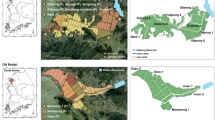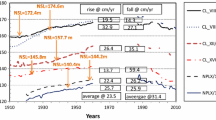Abstract
Basin irrigation is a common practice for growing water intensive crops like paddy. Irrigation water, when supplied through a network of canal, is often found to be inadequate to meet the crop water requirement uniformly throughout the irrigated command area. The most deprived are the cultivators of the lower end of the command, who resort to supplementing the crop water requirement by extractions from the ground. This practice is noticeable in irrigation system without a proper canal water distribution schedule and often result in water logging in the upper command regions contrasted with excessively depleted groundwater table in the lower commands. The present contribution attempts to model the conjunctive water use of such a canal irrigated command using physically based numerical sub-models for simulating surface flow, groundwater flow and the interlinking process of moisture movement through the unsaturated zone for a given quantum of supplied water and crop water demand. Individual models are validated to demonstrate their applicability in an integrated framework. Various plausible conjunctive water use scenarios are tested on a hypothetical command area practising basin irrigation to identify the best possible water distribution strategy under given constraints.








Similar content being viewed by others
References
Aravena J, Dussaillant A (2009) Storm-water infiltration and focused recharge modeling with finite-volume two-dimensional richards equation: application to an experimental rain garden. J Hydraul Eng 135(12):1073–1080
Arnold JG, Fohrer N (2005) Swat2000: current capabilities and research opportunities in applied watershed modelling. Hydrol Process 19(3):563–572
Barlow P, Ahlfeld D, Dickerman D (2003) Conjunctive-management models for sustained yield of stream-aquifer systems. J Water Resour Plann Manag 129(1):35–48
Belaineh G, Peralta R, Hughes T (1999) Simulation/optimization modeling for water resources management. J Water Resour Plann Manag 125(3):154–161
Biswas P (2016) Physically based numerical simulation model for conjunctive water use in basin irrigated canal command areas. Unpublished Doctoral Thesis, Indian Institute of Technology Kharagpur, West Bengal, India
Brouwer C, Prins K, Heibloem M (1989) Irrigation water management: irrigation scheduling. Training manual, pp 4
Calpe C (2003) Status of the world rice market in 2002
Celia MA, Bouloutas ET, Zarba RL (1990) A general mass-conservative numerical solution for the unsaturated flow equation. Water Resour Res 26(7):1483–1496
Cunge JA (1975) two-dimensional modelling of flood plains. In: unsteady flow in open channels, vol ii
Deepak K, Jat M (2006) Ediwahyunan Assessment of counjunctive use planning options: A case study of sapon irrigation command area of Indonesia. J Hydrol 328 (34):764–777
DHI (2012) Scientific Documentation MIKE 11 and MIKE 21, User Manual, MIKE FLOOD
DSC (2004) Tail-enders and other deprived in the canal irrigation system. Proceedings of National Workshop, pp 28–29
Emch P, Yeh W (1998) Management model for conjunctive use of coastal surface water and ground water. J Water Resour Plann Manag 124(3):129–139
Erduran KS, Kutija V, Macalister CR (2005) Finite volume solution to integrated shallow surface–saturated groundwater flow. Int J Numer Methods Fluids 49 (7):763–783
Hanson RT, Schmid W, Faunt CC, Lockwood B (2010) Simulation and analysis of conjunctive use with modflow’s farm process. Ground Water 48(5):674–689
Harbaugh AW (2005) MODFLOW-2005, the U.S. Geological Survey modular ground-water model–The Ground-Water Flow Process. U.S. Geological Survey Techniques and Methods 6-A16
Haverkamp R, Vauclin M, Touma J, Wierenga P, Vachaud G (1977) A comparison of numerical simulation models for one-dimensional infiltration. Soil Sci Soc Amer J 41(2):285–294
Kaledhonkar M, Keshari A (2006) Regional salinity modeling for conjunctive water use planning in kheri command. J Irrig Drain Eng 132(4):389–398
Karamouz M, Kerachian R, Zahraie B (2004) Monthly water resources and irrigation planning: Case study of conjunctive use of surface and groundwater resources. J Irrig Drain Eng 130(5):391–402
Kroes JG, Van Dam JC, Groenendijk P (2008) Swap version 3.2. theory description and user manual [m]. Report no., Alterra Rep. 1649, Alterra, Wageningen, Netherlands
Lai W, Ogden FL (2015) A mass-conservative finite volume predictor–corrector solution of the 1d richards equation. J Hydrol 523:119–127
Liu L, Cui Y, Luo Y (2013) Integrated modeling of conjunctive water use in a canal-well irrigation district in the lower yellow river basin. China J Irrig Drain Eng 139(9):775–784
Matsukawa J, Finney B, Willis R (1992) Conjunctive-use planning in mad river basin, california. J Water Resour Plann Manag 118(2):115–132
Murray-Rust D, Vander Velde E (1994) Conjunctive use of canal and groundwater in punjab, Pakistan: Management and policy options. Irrig Drain Syst 8(4):201–231
Peralta R, Cantiller R, Terry J (1995) Optimal large-scale conjunctive water-use planning: Case study. J Water Resour Plann Manag 121(6):471–478
Rao S, Bhallamudi S, Thandaveswara B, Mishra G (2004) Conjunctive use of surface and groundwater for coastal and deltaic systems. J Water Resour Plann Manag 130(3):255–267
Sarwar A, Eggers H (2006) Development of a conjunctive use model to evaluate alternative management options for surface and groundwater resources. Hydrogeol J 14(8):1676–1687
Ueda T, Ogawa S, Shioda K, Arulvijitskul P, Klinkhachorn P (2005) Recent irrigation practices in the upper east bank of the chao phraya delta. Paddy Water Environ 3(1):63–71
Vedula S, Mujumdar P, Sekhar GC (2005) Conjunctive use modeling for multicrop irrigation. Agric Water Manag 73(3):193–221
Weller J (1991) An evaluation of the porac river irrigation system. Irrig Drain Syst 5(1):1–17
Acknowledgments
This work is partially supported by Ministry of Water Resources, River Development & Ganga Rejuvenation, Government of India (Ref.: 21/117/2012-R&D/393-404).
Author information
Authors and Affiliations
Corresponding author
Rights and permissions
About this article
Cite this article
Biswas, P., Dhar, A. & Sen, D. A Numerical Simulation Model for Conjunctive Water Use in Basin Irrigated Canal Command Areas. Water Resour Manage 31, 3993–4005 (2017). https://doi.org/10.1007/s11269-017-1720-8
Received:
Accepted:
Published:
Issue Date:
DOI: https://doi.org/10.1007/s11269-017-1720-8




